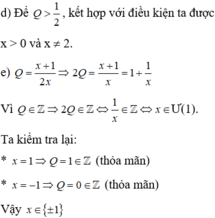Xác định giá trị của biểu thức để các biểu thức sau có nghĩa
d, x-y/2x+1
Hãy nhập câu hỏi của bạn vào đây, nếu là tài khoản VIP, bạn sẽ được ưu tiên trả lời.

a
Để biểu thức có nghĩa thì \(x-2\ne0\Rightarrow x\ne2\)
b
Để biểu thức có nghĩa thì \(2x+1\ne0\Rightarrow x\ne-\dfrac{1}{2}\)
c
Ủa câu c là (x-1)/(x^2+1) đúng không bạn:v
Để biểu thức có nghĩa thì \(x^2+1\ne0\)
Vì \(x^2\ge0\forall x\Rightarrow x^2+1>0\forall x\)
Vậy biểu thức có nghĩa với mọi giá trị x.
d
Để biểu thức có nghĩa thì \(xy-3y\ne0\Leftrightarrow y\left(x-3\right)\ne0\)
\(\Leftrightarrow\left\{{}\begin{matrix}y\ne0\\x-3\ne0\Rightarrow x\ne3\end{matrix}\right.\)
Vậy để biểu thức có nghĩa thì đồng thời \(y\ne0,x\ne3\)
a) \(\dfrac{5}{x-2}\)
Có nghĩa khi:
\(x-2\ne0\)
\(\Rightarrow x\ne2\)
b) \(\dfrac{x-y}{2x+1}\)
Có nghĩa khi:
\(2x+1\ne0\)
\(\Rightarrow2x\ne-1\)
\(\Rightarrow x\ne-\dfrac{1}{2}\)
c) \(\dfrac{x-1}{x^2+1}\)
Có nghĩa khi:
\(x^2+1\ne0\)
\(\Rightarrow x^2\ne-1\) (luôn đúng)
Vậy biểu thức được xác định với mọi x
d) \(\dfrac{ax+by+c}{xy-3y}=\dfrac{ax+by+c}{y\left(x-3\right)}\)
Có nghĩa khi:
\(y\left(x-3\right)\ne0\)
\(\Leftrightarrow\left[{}\begin{matrix}y\ne0\\x-3\ne0\end{matrix}\right.\)
\(\Leftrightarrow\left[{}\begin{matrix}y\ne0\\x\ne3\end{matrix}\right.\)

a) x ≠ 0 , x ≠ − 2
b) Ta có D = x 2 - 2x - 2.
c) Chú ý D = - x 2 - 2x - 2 = - ( x + 1 ) 2 - 1 ≤ -1. Từ đó tìm được giá trị lớn nhất của D = -1 khi x = -1.

a) x ≠ 2 và x ≠ 0
b) Rút gọn được Q = x + 1 2 x
c) Thay x = 2017 (TMĐK) vào Q ta được Q = 1009 2017


a: ĐKXĐ: x<>1; x<>-1
b: \(A=\dfrac{\left(x-1\right)^2}{\left(x-1\right)\left(x+1\right)}=\dfrac{x-1}{x+1}\)
c: Để A nguyên thì x+1-2 chia hết cho x+1
=>\(x+1\in\left\{1;-1;2;-2\right\}\)
=>\(x\in\left\{0;-2;-3\right\}\)

1) a) Căn thức có nghĩa \(\Leftrightarrow4-2x\ge0\Leftrightarrow2x\le4\Leftrightarrow x\le2\)
b) Thay x = 2 vào biểu thức A, ta được: \(A=\sqrt{4-2.2}=\sqrt{0}=0\)
Thay x = 0 vào biểu thức A, ta được: \(A=\sqrt{4-2.0}=\sqrt{4}=2\)
Thay x = 1 vào biểu thức A, ta được: \(A=\sqrt{4-2.1}=\sqrt{2}\)
Thay x = -6 vào biểu thức A, ta được: \(A=\sqrt{4-2.\left(-6\right)}=\sqrt{16}=4\)
Thay x = -10 vào biểu thức A, ta được: \(A=\sqrt{4-2.\left(-10\right)}=\sqrt{24}=2\sqrt{6}\)
c) \(A=0\Leftrightarrow\sqrt{4-2x}=0\Leftrightarrow4-2x=0\Leftrightarrow x=2\)
\(A=5\Leftrightarrow\sqrt{4-2x}=5\Leftrightarrow4-2x=25\Leftrightarrow x=\frac{-21}{2}\)
\(A=10\Leftrightarrow\sqrt{4-2x}=10\Leftrightarrow4-2x=100\Leftrightarrow x=-48\)

\(a,ĐK:x\ne\pm1\\ b,B=\dfrac{x^2+x-x^2-1}{2\left(x-1\right)\left(x+1\right)}=\dfrac{x-1}{2\left(x-1\right)\left(x+1\right)}=\dfrac{1}{2\left(x+1\right)}\\ c,B=-\dfrac{1}{2}\Leftrightarrow2\left(x+1\right)=-2\Leftrightarrow x+1=-1\Leftrightarrow x=-2\left(tm\right)\)

a: ĐKXĐ:\(x\notin\left\{2;0\right\}\)
b: \(C=\left(\dfrac{x\left(2-x\right)}{2\left(x^2+4\right)}-\dfrac{2x^2}{\left(x-2\right)\left(x^2+4\right)}\right)\cdot\left(\dfrac{2-x^2+x}{x^2}\right)\)
\(=\dfrac{-x^3+4x^2-4x-4x^2}{2\left(x-2\right)\left(x^2+4\right)}\cdot\dfrac{-\left(x-2\right)\left(x+1\right)}{x^2}\)
\(=\dfrac{x\left(x^2+4\right)}{2\left(x-2\right)\left(x^2+4\right)}\cdot\dfrac{\left(x-2\right)\left(x+1\right)}{x^2}=\dfrac{x+1}{2x}\)
c: Thay x=2017 vào C, ta được:
\(C=\dfrac{2017+1}{2\cdot2017}=\dfrac{1009}{2017}\)
có nghĩ khi mẫu số khác 0 : 2x+1 # 0 => x# -1/2